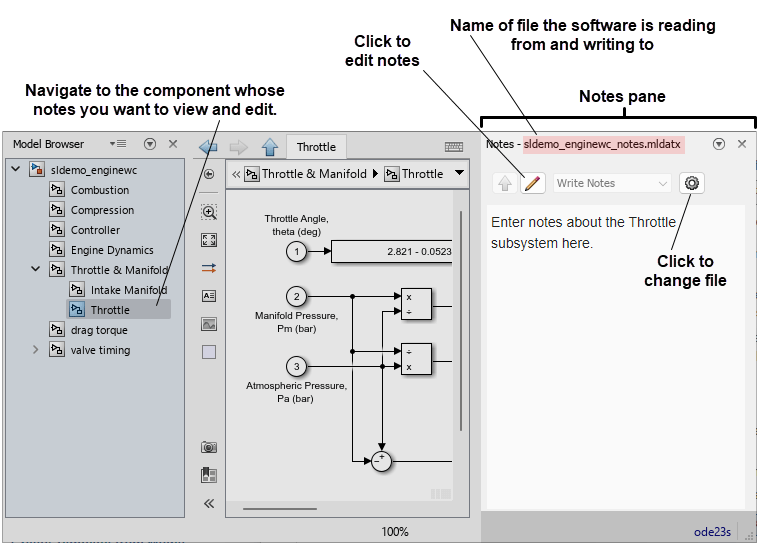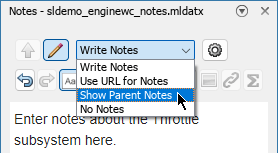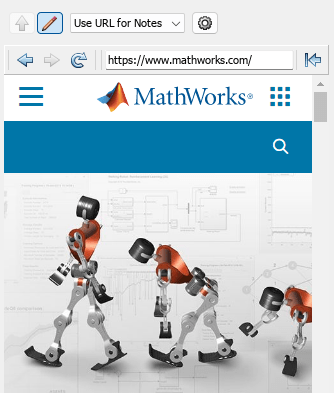Write In-Model Documentation Using Notes
To provide extensive background information or instructions for a model, you can write notes in the Notes pane of the Simulink® Editor. The notes can include text, images, hyperlinks, equations, and website content. To add labels, short descriptions, images, equations, and hyperlinks to the canvas, use annotations instead. For more information about annotations, see Annotate Models.
Notes are stored in a file with the extension .mldatx. You can create a
new notes file or edit an existing notes file. The notes file is saved separately from the
model file. If you move your model file to a different folder, the notes file does not move
with the model file. If the notes file is on the MATLAB® path, the association between the model file and the notes file persists. Notes
files contain the model name and version information, so you can check that the notes file
matches the model.
The software can only read from and write to one notes file at a time. However, you can create multiple notes files for use with the same model, for example, for users with different roles. The person using the model can load the file pertaining to their role.
The content the Notes pane displays is specific to the component in the model hierarchy you are in, for example, a chart or subsystem. If you navigate to a different component, you see the content for that component. For each component in your model, you can set what the Notes pane displays: notes associated with the component or with the parent component, the content of a website, or nothing.

View Notes
You can view notes in the Notes pane. To show the Notes pane, in the Simulink Toolstrip, on the Modeling tab, click the arrow on the far right of the Design section. In the Design gallery, under Review, click Model Notes. Alternatively, press Ctrl+Shift+N.
To find out which notes file you are viewing the contents of, check the top of the
Notes pane. If the model has an associated notes file, the top of the
Notes pane displays the name of the notes file the software is
reading from and writing to. If a model does not have an associated notes file, the top of
the Notes pane displays this message: This model does not have
notes associated with it.
To load and view the contents of a different notes file, click the Show Options button
![]() . Click the Use an existing notes file button
. Click the Use an existing notes file button
![]() . Select an MLDATX file and click
Open.
. Select an MLDATX file and click
Open.
To view the notes associated with a model component, navigate to the component. For
example, to view the notes for a subsystem, enter the subsystem. To set what the
Notes pane shows for a component, click the Edit Notes button
![]() . Then, from the drop-down list at the top of the
Notes pane, select one of these options.
. Then, from the drop-down list at the top of the
Notes pane, select one of these options.
Write Notes– Display the notes associated with the component.Use URL for Notes– Enter the URL of a website you want to display.Show Parent Notes– If the component has a parent component, display the notes associated with the parent component.No Notes– Hide the notes.
Add and Edit Notes
Navigate to the component you want to add notes to or whose note you want to edit.
Open the Notes pane.
Check the top of the Notes pane to see whether the model has an associated notes file.
If the model has an associated notes file and the Create a notes file
 and Use an existing notes file
and Use an existing notes file
 buttons are not visible in the
Notes pane, click the Show Options button
buttons are not visible in the
Notes pane, click the Show Options button
 .
.If the model does not have an associated notes file, or if you want to change the associated notes file, create a new notes file or open an existing notes file.
To create a new file, in the Notes pane, click the Create a notes file button
 . Enter a name for the notes file or use the default
name, then click Save.
. Enter a name for the notes file or use the default
name, then click Save. To open an existing file, in the Notes pane, click the Use an existing notes file button
 . Select a MLDATX file and click
Open.
. Select a MLDATX file and click
Open.
Enter edit mode. When you create a new notes file, you automatically enter edit mode. If you open an existing notes file, or if the model already has an associated notes file and you skipped the previous step, click the Edit Notes button
 to enter edit mode.
to enter edit mode.Add or edit the contents of the note.
To add text, enter the text in the text box.
To inherit the notes from the parent component, from the drop-down list at the top of the Notes pane, select
Show Parent Notes.
To add images, include hyperlinks, or add equations, use the Image
 , Link
, Link  , and Equation Editor
, and Equation Editor  buttons, respectively. You can mix text, images,
hyperlinks, and equations in the same note. You can include multiple images,
hyperlinks, and equations in the same note.
buttons, respectively. You can mix text, images,
hyperlinks, and equations in the same note. You can include multiple images,
hyperlinks, and equations in the same note.To use web content as the note, from the drop-down list at the top of the Notes pane, select
Use URL for Notes. In the text box in the Notes pane title bar, enter the web content URL. Then, press Enter. You can only display the contents of one URL in the note.
To toggle the notes to read-only mode, click the Read Notes button
 .
.
Note
The notes you add are saved automatically.
Hide and Show Notes
Navigate to the component whose notes you want to hide. For example, to hide the notes of a subsystem, enter the subsystem.
Open the Notes pane.
To enter edit mode, click the Edit Notes button
 .
.To hide the notes of the component you are in, from the drop-down list at the top of the Notes pane, select
No Notes.If the notes of the component you are in are hidden, to show the notes, select
Write Notes.
To toggle the notes to read-only mode, click the Read Notes button
 .
.